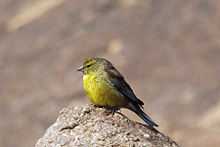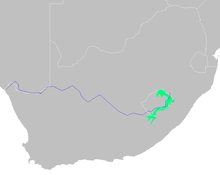Drakensberg Siskin
| Drakensberg Siskin | |
|---|---|
 | |
| A male | |
.jpg) | |
| A female at Sani Pass | |
| Conservation status | |
| Scientific classification | |
| Kingdom: | Animalia |
| Phylum: | Chordata |
| Class: | Aves |
| Order: | Passeriformes |
| Family: | Fringillidae |
| Genus: | Serinus |
| Species: | S. symonsi |
| Binomial name | |
| Serinus symonsi (Roberts 1916) | |
 | |
| General range: the Drakensberg alti-montane grasslands | |
| Synonyms | |
|
Crithagra symonsi | |
The Drakensberg Siskin, (Serinus symonsi), is a small passerine bird in the finch family. It is an endemic resident breeder in the eastern Cape Province Transkei and western Natal in South Africa, and in Lesotho. It is sometimes assigned to the genus Pseudochloroptila as Pseudochloroptila symonsi .
This species is sometimes considered to be conspecific with the Cape Siskin, Serinus totta of southern Cape Province, in which case the nominate western form is S. t totta, and the eastern form is S. t. symonsi.
This locally common but shy and unobtrusive siskin is found in the scrubby valleys and hillsides of the Drakensberg mountains.
Description
The Drakensberg Siskin averages 13–14 cm in length. The tail has white sides, a feature which is diagnostic for both sexes, and especially visible in flight. The adult male has a faintly streaked light brown back, light brown wing coverts, rump and upper tail, and yellow underparts. The head and nape sides are yellowish grey and olive. The throat is bright yellow, but the rest of the underparts are a somewhat duller shade.
The female has similar but duller upperparts and has no yellow in the plumage. The head and underparts are buff with much fine dark brown streaks on the head and breast. The juvenile plumage is much like the female’s but with heavier streaking.
There is no range overlap with the slightly smaller Cape Siskin, which has white spots on the flight feathers and tail and more uniform upperparts.
The Drakensberg Siskin’s call is a schwee, often given in flight. and the song, like that of Cape Siskin, is a weak, pleasant warble similar to the Yellow-fronted Canary.
Behaviour
Breeding
One reason for the taxonomic uncertainty with this species is that, if it is a true siskin, it is the only one which breeds in cavities. A shallow cup nest is constructed in cracks or holes in rocks, on ledges or amongst vegetation, especially ferns. Natural hollows in trees are rarely used.
The nest is constructed by the female with fine plant material, lined with plant down and animal hair. The clutch is three or four, occasionally five, eggs, incubated by the female. She is fed by the male on the nest by regurgitation.
Feeding
The Drakensberg Siskin is seen in pairs or small flock, moving unobtrusively through bushes and scrub as it forages for seeds (including proteas), buds and insects.
Phylogeny
It has been obtained by Antonio Arnaiz-Villena et al.[2]
References
- ↑ BirdLife International (2012). "Serinus symonsi". IUCN Red List of Threatened Species. Version 2013.2. International Union for Conservation of Nature. Retrieved 26 November 2013.
- ↑ Zamora, J; Moscoso J, Ruiz-del-Valle V, Ernesto L, Serrano-Vela JI, Ira-Cachafeiro J, Arnaiz-Villena A (2006). "Conjoint mitochondrial phylogenetic trees for canaries Serinus spp. and goldfinches Carduelis spp. show several specific polytomies". Ardeola. 53(1): 1–17.
- Ian Sinclair, Phil Hockey and Warwick Tarboton, SASOL Birds of Southern Africa (Struik 2002) ISBN 1-86872-721-1
- Clement, Harris and Davis, Finches and Sparrows by ISBN 0-7136-8017-2
